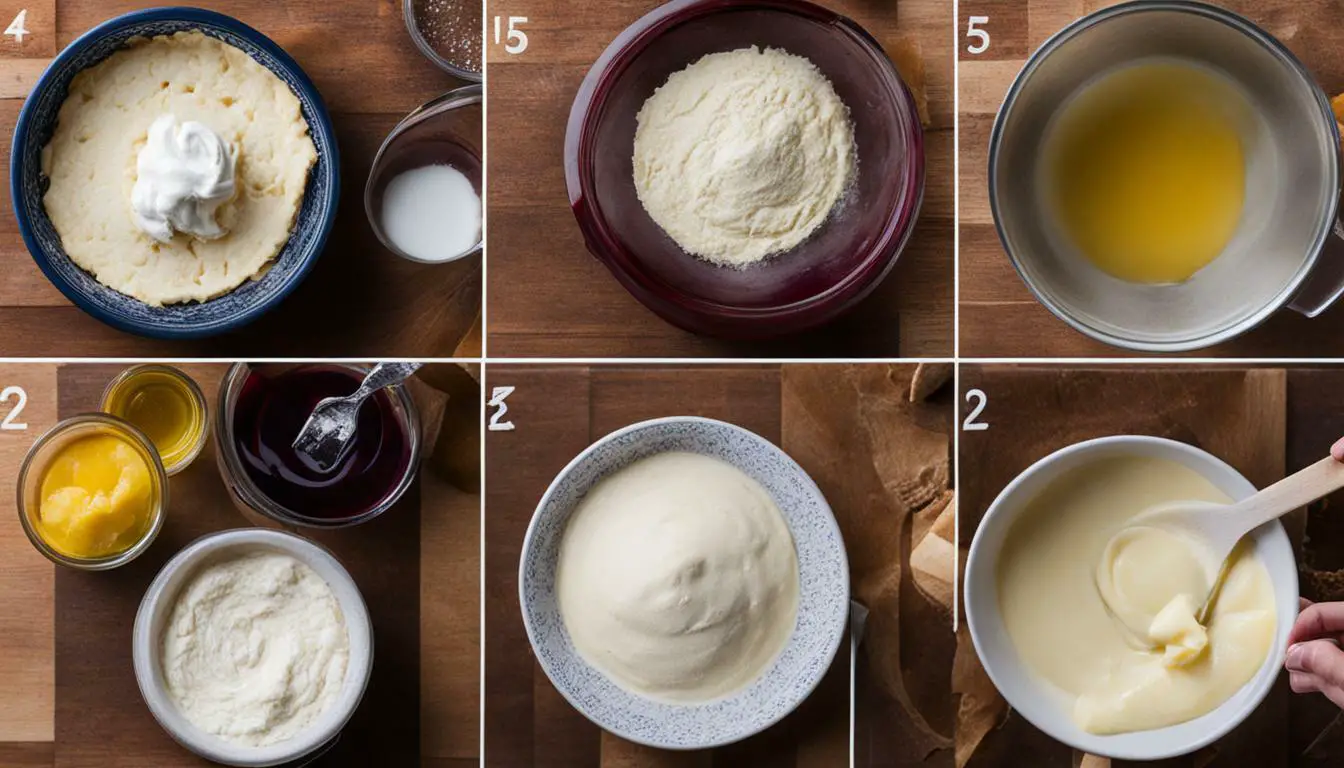
This post may contain affiliate links. Please read my disclosure for more information.
Looking for alternatives to vinegar in your pie dough? Discover 9 ideal substitutes that will help you achieve perfect results every time.
Balsamic vinegar substitute: Use 1 tablespoon cider vinegar or red wine vinegar plus ½ teaspoon sugar for every 1 tablespoon of balsamic vinegar.
Apple cider vinegar substitute: Rice wine vinegar, distilled white vinegar, or white wine vinegar can be used as a 1:1 substitute for apple cider vinegar. If using red wine vinegar, add about 1 teaspoon extra per tablespoon used.
Fruit vinegar substitute: If a specific fruit vinegar is not available, apple cider vinegar or a wine vinegar can be used as a replacement.
Herb vinegar substitute: If herb vinegar is not available, cider, white, malt, or wine vinegar can be used as substitutes.
Malt vinegar substitute: Apple cider vinegar or lemon juice are the best options for substituting malt vinegar.
Rice vinegar substitute: There isn’t a great substitute for rice vinegar, but white wine vinegar or apple cider vinegar can be used as replacements. Add ¼ teaspoon of sugar per tablespoon of rice vinegar being substituted.
White balsamic vinegar substitute: Substitute white balsamic vinegar with white wine vinegar or rice wine vinegar to prevent color changes in the recipe.
White vinegar substitute: Apple cider vinegar or malt vinegar can be used as substitutes for white vinegar. Lemon or lime juice can also be used, depending on the recipe.
Wine vinegar substitute: Apple cider vinegar, white balsamic vinegar, or white vinegar can be used as substitutes for wine vinegar.
Remember to adjust the quantity for each substitute to match the amount of vinegar called for in the recipe.
Balsamic Vinegar Substitute: Cider Vinegar or Red Wine Vinegar with Sugar
If you don’t have balsamic vinegar on hand, you can create a similar flavor profile by using cider vinegar or red wine vinegar, along with a hint of sugar. Here are the steps:
- Measure 1 tablespoon of cider vinegar or red wine vinegar for every tablespoon of balsamic vinegar required in your recipe.
- Add ½ teaspoon of sugar for each tablespoon of vinegar used. This will help balance the acidity and sweetness.
- Mix the vinegar and sugar together until the sugar dissolves completely.
Using this substitute will provide a tangy and slightly sweet taste to your pie dough, mimicking the flavors of balsamic vinegar. It’s a great option when you need an alternative in a pinch.
Remember, when substituting ingredients, taste preferences may vary. Feel free to adjust the quantities of vinegar and sugar to your liking. Keep a note of your substitutions to replicate or adjust the flavor in future recipes.
Apple Cider Vinegar Substitute: Rice Wine Vinegar, White Vinegar, or White Wine Vinegar
Need a substitute for apple cider vinegar in your pie dough? Rice wine vinegar, white vinegar, or white wine vinegar can easily step in with equal success. These alternatives provide a similar acidity and flavor profile, ensuring your pie comes out just as delicious.
- Rice wine vinegar: Rice wine vinegar is a popular choice for Asian cuisine, but it can also be used in baking. Use an equal amount of rice wine vinegar as a 1:1 substitute for apple cider vinegar in your pie dough. For added balance, consider adding ¼ teaspoon of sugar per tablespoon of rice wine vinegar used.
- White vinegar: Another versatile pantry staple, white vinegar works well as a substitute for apple cider vinegar. Simply replace the apple cider vinegar with an equal amount of white vinegar in your dough recipe. The tangy flavor will still shine through, creating a delicious pie crust.
- White wine vinegar: If you have white wine vinegar on hand, it can also be used in place of apple cider vinegar. The flavor profile of white wine vinegar is slightly milder and less acidic, but it still provides a pleasant tang. Use the same amount of white wine vinegar as you would apple cider vinegar in your pie dough recipe.
Remember, when substituting apple cider vinegar with rice wine vinegar, white vinegar, or white wine vinegar, it’s essential to adjust the quantity to match the amount of vinegar called for in the recipe. This ensures the proper balance of flavors and acidity in your homemade pie dough.
Other Vinegar Substitutes for Different Varieties
Don’t have a specific type of vinegar for your pie dough? No worries! Find suitable substitutes for fruit vinegar, herb vinegar, malt vinegar, rice vinegar, white balsamic vinegar, and wine vinegar right here.
Fruit vinegar substitute: If a specific fruit vinegar is not available, apple cider vinegar or a wine vinegar can be used as a replacement.
Herb vinegar substitute: If herb vinegar is not available, cider, white, malt, or wine vinegar can be used as substitutes.
Malt vinegar substitute: When substituting for malt vinegar, apple cider vinegar or lemon juice are the best options.
Rice vinegar substitute: While there isn’t a perfect substitute for rice vinegar, white wine vinegar or apple cider vinegar can be used instead. Remember to add 1/4 teaspoon of sugar for every tablespoon of rice vinegar being substituted.
White balsamic vinegar substitute: To prevent color changes in your recipe, substitute white balsamic vinegar with white wine vinegar or rice wine vinegar.
Wine vinegar substitute: When you don’t have wine vinegar on hand, apple cider vinegar, white balsamic vinegar, or white vinegar can be used as substitutes.
Remember to adjust the quantity for each substitute to match the amount of vinegar called for in the recipe.
Conclusion
With these 9 ideal substitutes for vinegar in pie dough, you can ensure your pies always turn out perfectly, no matter what type of vinegar you have on hand.
If you need a substitute for balsamic vinegar, try using 1 tablespoon of either cider vinegar or red wine vinegar mixed with ½ teaspoon of sugar for every 1 tablespoon of balsamic vinegar required in your recipe. This combination will provide a similar flavor profile and help enhance the taste of your pie crust.
For apple cider vinegar, you can easily swap it out with rice wine vinegar, distilled white vinegar, or white wine vinegar in a 1:1 ratio. If you prefer using red wine vinegar, just add about 1 teaspoon extra per tablespoon used to maintain the desired acidity level.
When it comes to fruit vinegar, if you don’t have a specific one on hand, apple cider vinegar or any wine vinegar can be used as a suitable replacement. Similarly, for herb vinegar, you can use cider vinegar, white vinegar, malt vinegar, or wine vinegar as substitutes without compromising on taste.
For malt vinegar, apple cider vinegar or lemon juice are excellent alternatives. And while there isn’t a perfect substitute for rice vinegar, white wine vinegar or apple cider vinegar can be used instead. Just remember to add ¼ teaspoon of sugar per tablespoon of rice vinegar being substituted to maintain the desired flavor.
In the case of white balsamic vinegar, using white wine vinegar or rice wine vinegar will prevent any color changes in your recipe. If you don’t have white vinegar on hand, apple cider vinegar or malt vinegar can serve as suitable alternatives. Depending on the recipe, you can also use lemon or lime juice as substitutes for white vinegar.
Lastly, when it comes to wine vinegar, apple cider vinegar, white balsamic vinegar, or white vinegar are all good substitutes. Adjust the quantity of each substitute based on the amount of vinegar called for in your recipe to ensure the perfect balance of flavors.
With these versatile substitutes, you can confidently bake mouthwatering pies without worrying about the availability of vinegar. Whether it’s balsamic vinegar, apple cider vinegar, fruit vinegar, herb vinegar, malt vinegar, rice vinegar, white balsamic vinegar, white vinegar, or wine vinegar, there’s always a suitable alternative to create the perfect pie dough.
FAQ
Can I substitute balsamic vinegar in pie dough?
Yes, you can use 1 tablespoon cider vinegar or red wine vinegar plus ½ teaspoon sugar for every 1 tablespoon of balsamic vinegar.
What can I use as a substitute for apple cider vinegar in pie dough?
Rice wine vinegar, distilled white vinegar, or white wine vinegar can be used as a 1:1 substitute for apple cider vinegar. If using red wine vinegar, add about 1 teaspoon extra per tablespoon used.
What can I use if I don’t have fruit vinegar for pie dough?
If a specific fruit vinegar is not available, apple cider vinegar or a wine vinegar can be used as a replacement.
What can I substitute for herb vinegar in pie dough?
If herb vinegar is not available, cider, white, malt, or wine vinegar can be used as substitutes.
Can I substitute malt vinegar in pie dough?
Yes, apple cider vinegar or lemon juice are the best options for substituting malt vinegar.
What can I use as a substitute for rice vinegar in pie dough?
While there isn’t a perfect substitute for rice vinegar, white wine vinegar or apple cider vinegar can be used as replacements. Add ¼ teaspoon of sugar per tablespoon of rice vinegar being substituted.
How can I substitute white balsamic vinegar in pie dough without changing the color?
Substitute white balsamic vinegar with white wine vinegar or rice wine vinegar to prevent color changes in the recipe.
What can I use as a substitute for white vinegar in pie dough?
Apple cider vinegar or malt vinegar can be used as substitutes for white vinegar. Lemon or lime juice can also be used, depending on the recipe.
Can I substitute wine vinegar in pie dough?
Yes, apple cider vinegar, white balsamic vinegar, or white vinegar can be used as substitutes for wine vinegar.


